
Hieronymus Bosch was a Dutch/Netherlandish painter from Brabant. He is one of the most notable representatives of the Early Netherlandish painting school. His work, generally oil on oak wood, mainly contains fantastic illustrations of religious concepts and narratives. Within his lifetime his work was collected in the Netherlands, Austria, and Spain, and widely copied, especially his macabre and nightmarish depictions of hell.

The Garden of Earthly Delights is the modern title given to a triptych oil painting on oak panel painted by the Early Netherlandish master Hieronymus Bosch, between 1490 and 1510, when Bosch was between 40 and 60 years old. It has been housed in the Museo del Prado in Madrid, Spain since 1939.

The Haywain Triptych is a panel painting by Hieronymus Bosch, now in the Museo del Prado, Madrid, Spain. A date of around 1516 has been established by means of dendrochronological research. The central panel, signed "Jheronimus Bosch", measures 135 cm × 200 cm and the wings measure 147 cm × 66 cm. The outside shutters feature a version of Bosch's The Wayfarer.

Giovanni Girolamo Savoldo, also called Girolamo da Brescia, was an Italian High Renaissance painter active mostly in Venice, although he also worked in other cities in northern Italy. He is noted for his subtle use of color and chiaroscuro, and for the sober realism of his works, which are mostly religious subjects, with a few portraits. His portraits are given interest by their accessories or settings; "some even look like extracts from larger narratives".

The Conjurer is a painting by Early Netherlandish painter Hieronymus Bosch or his workshop, executed around 1502.
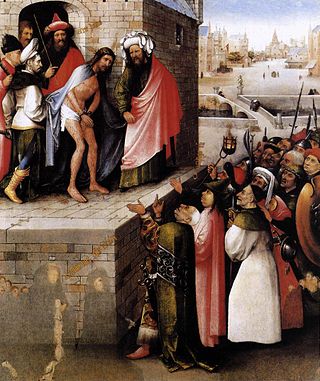
Ecce Homo is a painting of the episode in the Passion of Jesus by the Early Netherlandish painter Hieronymus Bosch, painted between 1475 and 1485. The original version, with a provenance in collections in Ghent, is in the Städel Museum in Frankfurt; a copy is held the Museum of Fine Arts in Boston. The painting takes its title from the Latin words Ecce Homo, "Behold the Man" spoken by the Roman Prefect Pontius Pilate when Jesus is paraded before a baying, angry mob in Jerusalem before he is sentenced to be crucified.
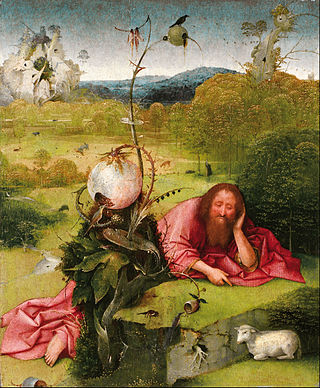
St. John the Baptist in the Wilderness is an oil painting by Hieronymus Bosch, created c. 1489. The painting was acquired by the Spanish collector Lázaro Galdiano in 1913. It is on display in the Lázaro Galdiano Museum, in Madrid, Spain.
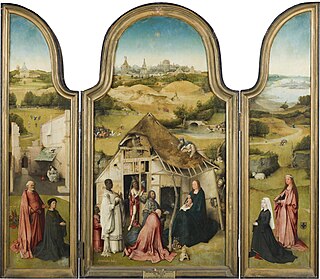
The Adoration of the Magi or The Epiphany is a triptych oil painting on wood panel by the Netherlandish artist Hieronymus Bosch, executed around 1485–1500. It is now in the Museo del Prado in Madrid, Spain.

Christ Carrying the Cross is a painting attributed to a follower of Hieronymus Bosch. It was painted in the early 16th century, presumably between 1510 and 1535. The work is housed in the Museum of Fine Arts in Ghent, Belgium. The painting is notable for its use of caricature to provide grotesque-looking faces surrounding Jesus.

The Crucifixion of Saint Wilgefortis is a c. 1497 triptych by the Early Netherlandish painter Hieronymus Bosch. The subject of the painting has been uncertain, and it has also been known as the Triptych of the Crucified Martyr, or The Crucifixion of Saint Julia, but is now believed to depict Saint Wilgefortis.

The Hermit Saints is a religious oil on panel painting displayed as a triptych, meaning it is one whole painting composed of three separate scenes. This artwork was made by the Renaissance artist Hieronymus Bosch, dating from 1493. The entirety of the triptych painting measures 86 by 60 centimetres. This artwork is currently being housed at the Gallerie dell'Accademia, Venice.
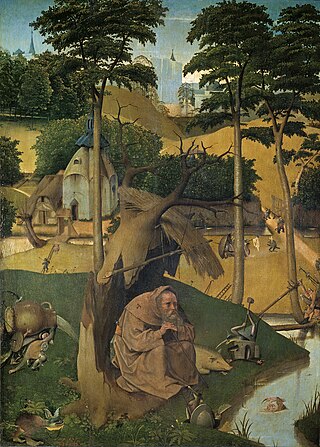
The Temptation of St. Anthony is a painting of disputed authorship, attributed to either Hieronymus Bosch or a follower. It is now in the Museo del Prado, in Madrid.

The Last Judgment is a triptych by Hieronymus Bosch, created after 1482.

Saint Jerome in the Wilderness is an unfinished painting by the Italian Renaissance artist Leonardo da Vinci, dated c. 1480–1490. A recent study linked to the Lady with an Ermine carried out by Leonardo da Vinci at the same time supports this hypothesis .The composition of the painting has been drafted in monochrome onto the primed wooden panel. At an unknown date after Leonardo's death, the panel was cut into five pieces before eventually being restored into its original form.

The Triptych of Temptation of St. Anthony is an oil painting on wood panels by the Early Netherlandish painter Hieronymus Bosch, dating from around 1501. The work portrays the mental and spiritual torments endured by Saint Anthony the Great, one of the most prominent of the Desert Fathers of Egypt in the late 3rd and early 4th centuries. The Temptation of St. Anthony was a popular subject in Medieval and Renaissance art. In common with many of Bosch's works, the triptych contains much fantastic imagery. The painting hangs in the Museu Nacional de Arte Antiga in Lisbon.

The Last Judgment is a triptych of disputed authorship, either by Hieronymus Bosch, his workshop, or a collaboration between artist and workshop. It was created after 1486.
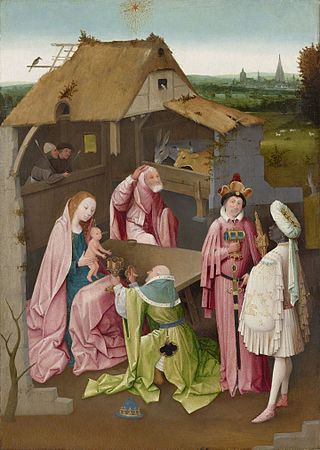
The Adoration of the Magi is an oil painting on wood panel attributed to the workshop of Netherlandish artist Hieronymus Bosch, executed around 1499. It is housed in the Philadelphia Museum of Art, USA. The museum's catalog assign it to around 1518, as having been finished by Bosch's workshop. According to Dendochronologic research, it could have been painted in 1493–1499.

The Adoration of the Magi is an oil painting on wood panel by Netherlandish artist Hieronymus Bosch, executed around 1475. It is housed in the Metropolitan Museum, New York, US. A prominent feature of this painting is the strong perspective effect and also the copious use of gold leaf, which is not very typical for Bosch. The pigments employed are red lake, azurite, lead-tin-yellow and ochres.

St Jerome in the Wilderness is a tempera on panel painting, measuring 48 by 36 cm and attributed to Andrea Mantegna. It dates to between 1449 and 1450 and is now in the São Paulo Museum of Art.

The Flood Panels are two double-sided painted panels attributed to Hieronymus Bosch, dating to c. 1514 and now in the Museum Boijmans Van Beuningen in Rotterdam.




















